What to expect from 12 games coming to the HTC Vive this year
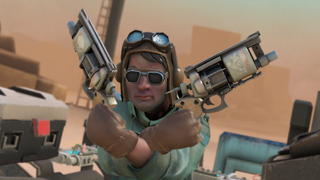
After two hours of VR demos, reality starts to feel off. I spent 15 minutes inside 12 wholly distinct VR worlds at Valve’s developer showcase on Wednesday, and in the breaks between my brain struggled to reassert normalcy. I stared at my iPhone, checking up on the outside world, but something just felt wrong. It was so small, its screen so two dimensional. Why did it feel like it was a mile from my face? Where was all the depth?
This is what happens to me when I adjust to a bright screen being strapped right in front of my eyeballs, apparently. I’m already envisioning an explosion of dystopic VR sci-fi over the next 10 years that makes Strange Days look passe. But in this case, my crisis of reality was for a good cause: I got to try out 12 of the games launching on the HTC Vive later this year, and all of them had something fun to offer.
Some of these games are brand new; others have been gestating under the radar for months, and a few more have been demoed many times, but still had something new to show at Valve’s shindig. None of them are finished, either, though most plan to make the Vive launch a few months from now.
Here are my thoughts on each of them, and why they’re all worth keeping an eye on.
For more VR hardware coverage, check out my recent comparison between the Oculus Rift and HTC Vive Pre.
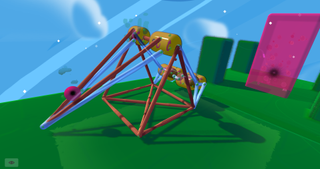
Fantastic Contraption
A building game with the most creative UI I’ve ever experienced in VR. So many VR games still abstract interface to systems that work well on 2D screens: menus that you select and navigate with a mouse or controller, for example. Fantastic Contraption tosses that idea.
The demo I tried gave me a few basic building blocks to work with—wheels and rods to connect them—and an object I needed to move to a nearby goal. At first the pieces I needed were right in front of me, but then the devs taught me how to spawn more. Every form of control in the game makes smart use of the virtual space. To spawn more wheels, I just held a controller above my head, pressed a button, and pulled up. Poof! A wheel popped out of my head. Reaching over my shoulder, like I was unsheathing a sword, spawned a rod. Pointing to the sky spawned a pin I could use to pop other pieces (my delete tool).
The menu lobby was a 3D space with little dioramas I could place on a pedestal. To load them, I simply mimed removing the ‘menu helmet’ I’d put on to get to the lobby, and then I was in the level. The same system worked for loading other players’ contraptions, which I could then watch complete a challenge to gain inspiration.
I think Fantastic Contraption stands to be VR’s equivalent of Besieged, with ridiculous and silly creations flopping around as physics asserts itself. I don’t know how deep its creation tools will go, but the builders among us will get many, many hours of entertainment from this one. And I expect to see a ton of VR games adopt similar user interfaces.
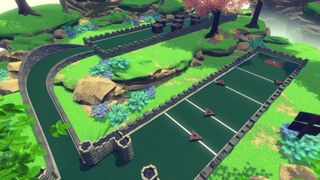
Cloudlands Minigolf
I love minigolf, so I had good fun putting my way across half of Cloudlands’ course. The first few holes closely mimicked the real thing with straightforward patterns, but by the end they’d gotten much more inventive. In one, I had to putt through an elaborately vertical course akin to a 3D marble maze, dropping the ball down each level until I found the goal. On the final hole, I had to putt through a concentric series of spinning obstacles, which threatened to ricochet the ball right back at me. I got lucky on that one and beat it well under par. Yes, I’m bragging a bit.
The physics of minigolf felt close to spot on, although without the physical feedback of hitting a real ball, I kept expecting it to travel farther when I gave it what felt like a hard putt.
I like Cloudlands’ approach to virtual minigolf, making it more puzzley than the real thing could be, with longer courses to compensate for how quickly the game can move along. From what I played, though, I’d like to see it be much more ambitious. The courses have slopes but no subtle terrain deformation to add challenge to putting. And it’s short, with a planned 18 hole course for launch. I can see playing through that three or four times and having no reason to come back. The developers are hard at work on supporting multiplayer now, and I could see this being a Wii Sports-esque introduction to VR at parties. But the more elaborate and ostentatious its courses become, the more fun it’ll be.
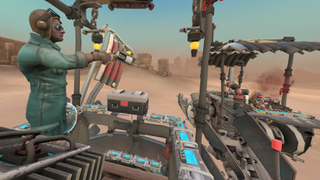
Hover Junkers
When Hover Junkers’ developers name-dropped Goldeneye as an inspiration, I knew I was in for a good time. The first person shooter gets around the VR movement problem by putting you on a hovering junk barge. In one hand, you hold a multitool that, among other things, lets you control the barge like a throttle. In the other, you can use a weapon to fire at your enemies. The game supports eight-player multiplayer in a variety of modes (that’s where the Goldeneye influence really comes in).
Two players will be able to team up on the same barge, with one driving and picking up scrap (which you attach to the ship to provide new defenses to hide behind) and the other firing. Hover Junkers has the coolest reload system I’ve seen in a VR shooter so far, too. With a revolver, you press the Vive controller’s touchpad to eject the clip, then rotate your thumb around it to reload each chamber. A flick of the wrist snaps the cylinder back in place. Reloading a shotgun feels similarly awesome, and is challenging in the heat of battle.
I had trouble piloting the barge and shooting at the same time, and the game felt fairly empty with only one other human player and a couple AI bots. But I think Hover Junkers will really shine with eight players, and it’s great to see someone offering a VR game with real multiplayer support working. Of all the games I played, Hover Junkers felt the meatiest.
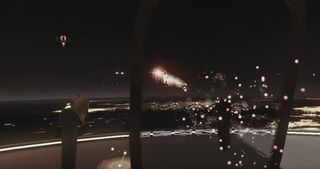
Space Pirate Trainer
My favorite game of the day, and a total surprise. Space Pirate Trainer doesn’t do anything innovative, but it just feels joyfully right. It’s meant to be the VR equivalent of an 80s arcade game like Galaga. Swarms of robot drones attack you, and you fire back with laser pistols in both hands, dodging incoming fire at the same time. Three hits and you’re dead, but slow motion kicks in when the baddies fire, and you can also equip a shield to block their attacks.
It’s fast, fun, and feels pinpoint accurate. The developers have a lot of ideas on how they want to expand the game before release. I’ve got more thoughts on Space Pirate Trainer and an interview with its lead designer, which will be posted separately in the near future.

Arizona Sunshine
Another first-person shooter, which I’m sad to say really doesn’t do anything for me. You stand still and zombies walk or run at you. Shoot them, then shoot a target to advance to the next fixed location. Firing the guns felt fairly flat, the zombies were an uninteresting enemy, and the only real challenge came from reloading in the heat of the moment, which wasn’t nearly as exciting as it was in Hover Junkers. Reloading here simply requires pressing the touchpad to eject a magazine, then moving the gun near your chest, where you equip an ammo belt.
The demo did end with a spooky cave that made smart use of VR and positional audio. I could hear zombies coming at me from multiple angles, but could only see in brief moments as my flashlight flickered on and off. Without that atmosphere, Arizona Sunshine falls pretty flat.

Tilt Brush
Not really a game, but a wonderful three-dimensional art tool from Google nonetheless. Tilt Brush is intuitive enough to let you draw cool stuff with ease, and complicated enough to produce amazing work in the hands of skilled artists. I pine for two-player support, which it doesn’t currently have. I think I’d enjoy using it much more with a friend, myself. But it’s still hard to describe the awe of stepping into someone else’s drawing and walking around it. The online community for this game is going to produce some amazing works of art to experience.
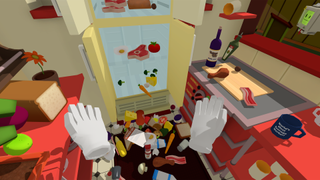
Job Simulator
I’ve played Job Simulator a few times now, but this job was new: a completely reworked kitchen, with a set of dishes to cook and a healthy dose of the game’s wonderful sense of humor. My favorite bit was dealing with a famous French food critic bot, who reminded me of Futurama’s Calculon. I successfully wooed him by placing a key ingredient—a stack of money—on top of his dish.
Interacting with Job Simulator’s densely packed environments is joyful, although I found myself wishing for more open-ended options in this demo. According to the developers, the demo was intended to be longer and opened up after the part I played, which was intended to help me learn my way around the kitchen. I don’t know how replayable each job in the game will feel, but Job Simulator will absolutely be one of those “you’ve got to try this” experiences VR early adopters use to give their friends a taste of how fun it can be to mess around in a virtual space.
Also, you eat a burrito to close out the experience. VR user interfaces, y'all.

Final Approach
I’ve played Final Approach with the Oculus Touch more than once, but this demo had some much more complicated levels in it. The developers took their initial concept (draw flight paths to land planes and keep them from running into each other or the ground) and added some sim/god game elements, with more unique mechanics for different vehicles and levels.
In a naval battle level, I landed fighters on an aircraft carrier, used helicopers to rescue ejected pilots, and flew a plane near a destroyer so the ship’s guns could shoot down pursuers. Controlling the helicopters was very finicky—getting the altitude right to lower a rescue crane arm just didn’t work a couple times—and the god elements, while a nice touch, were pretty basic. In one sequence, I warped down to a generator to press four buttons in a set order to start it up. Not exactly a creative puzzle.
My biggest problem with Final Approach was physical. Because I was standing over (or, I suppose, inside) this virtual diorama world, I was looking down the entire time. My neck hurt by the end of the 15 minute demo. Looking down with a fairly heavy headset on your face isn’t the best idea. I’m not sure how to solve that one.
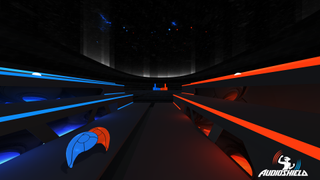
Audioshield
Surprise! The creator of Audiosurf has made a music game just for VR, and this was its grand debut. It’s a fairly simple game with only about six months of work behind it, but its offers Audiosurf’s trademark draw: an algorithm that converts any song you feed it into gameplay that matches the beat. In this case, gameplay means moving your arms to touch a series of orbs as they descend towards you, in time with the music. It’s fun and a damn good workout, but I’m worried about its simplicity. (And the screenshot above really doesn't do it justice).
I talked to developer Dylan Fitterer about that very thing, and have more thoughts and an interview on Audioshield to post separately.
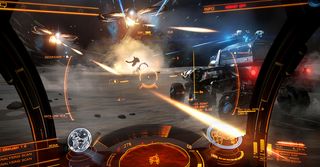
Elite: Dangerous
I don’t have too much to say about Elite: Dangerous—it’s already proven that a space sim can work amazingly in VR, and sitting in a comfortable gaming chair with HOTAS mounted on my left and right only made that experience better. In addition to a bit of space dogfighting, I got to drive a rover around an alien planet, something new to the Horizons expansion. Doing so resulted in the most motion sickness I’ve felt in VR in a long time. Usually that motion sickness comes from poor design or hardware, but in this case, it was just the bumpy nature of driving a buggy across a low gravity environment. It worked exactly as it should, but my brain did not care for that bounciness.
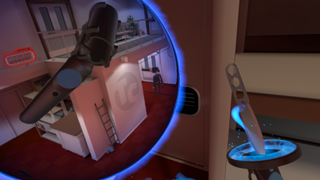
Budget Cuts
The most common favorite among attendees at Valve’s developer showcase, from everyone I talked to. Budget Cuts is a stealth adventure game that uses teleportation to move you around an expansive environment. You use the trigger on one controller to shoot an orb where you want to go, then press its grip buttons to warp to it. Pretty quickly it has you warping through air vents and up into ceiling crawlspaces to navigate an office building patrolled by deadly robots.
The only “puzzles” in the demo were disappointingly simplistic—find a key in a drawer, unlock a safe, and press a button to turn off a force field to advance. But complex puzzles don’t really work in 15 minute demos, so I hope to see the full game offer much more complexity. The deadly robots are cute and the whole game has a bit of a Portal vibe (and not just because you’re teleporting yourself through portals).
The developers told me the intent is for this to be more of a stealth game than a puzzle game, although they pointed out that stealth games are pretty puzzle-heavy, anyway. Moving around elegantly with the portals feels fumbly, at first, but watch this trailer for a glimpse of how smooth it can be with some practice.
Along with Hover Junkers, Budget Cuts felt like the most complete game of everything at the event.
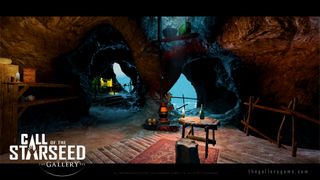
Call of the Starseed: The Gallery
It’s Myst! I mean, not really. But basically. Call of the Starseed is a Myst-like first person puzzler, where you adventure through a quiet world and solve puzzles scattered through the environment. They’re more real-world puzzles than, say, those found in the Witness; one involves cracking some morse code, while another requires finding a flaregun and using it to ring three bells as a signal to a lighthouse keeper on the mysterious island (see?) you’re stuck on.
Starseed’s world is detailed and brimming with atmosphere, and as long as the puzzles are well-designed I can see a lot of adventure game fans absolutely loving spending a few hours immersed in it. The developers plan on making it an episodic series, with 2-3 hour episodes coming out every six months or so (it’s a small team, and the production value feels pretty lush already).
From the few minutes I played, there was already some great voice work on display, and Starseed uses a teleportation system I like even more than Budget Cuts’. You simply press on the touchpad to bring up a teleportation marker, then look where you want to go (with your eyes!) and release to warp. Scrolling your thumb across the touchpad will pivot the direction you’re facing when you land. It’s a fairly elegant solution, and while future VR adventure games will undoubtedly refine it into something even better, it’s a strong starting point.

Wes has been covering games and hardware for more than 10 years, first at tech sites like The Wirecutter and Tested before joining the PC Gamer team in 2014. Wes plays a little bit of everything, but he'll always jump at the chance to cover emulation and Japanese games.
When he's not obsessively optimizing and re-optimizing a tangle of conveyor belts in Satisfactory (it's really becoming a problem), he's probably playing a 20-year-old Final Fantasy or some opaque ASCII roguelike. With a focus on writing and editing features, he seeks out personal stories and in-depth histories from the corners of PC gaming and its niche communities. 50% pizza by volume (deep dish, to be specific).
Most Popular


